Coronavirus: Eight ways life in the UK has changed
- Published
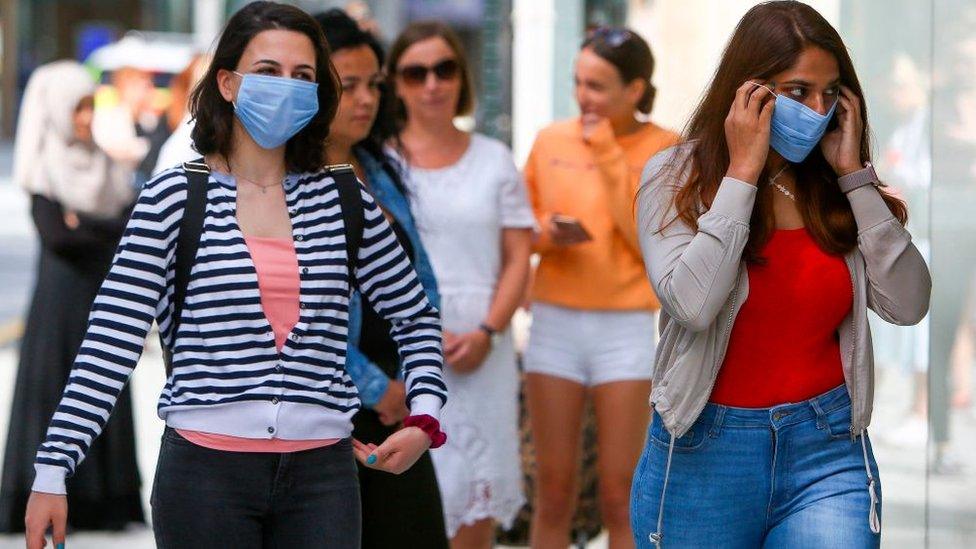
Restrictions on daily life in many parts of the UK - to try to curb the spread of coronavirus - have been eased in recent weeks.
Employers in England can bring staff back to the workplace and people can use public transport for non-essential journeys (while wearing face coverings).
Many pubs, shops and restaurants have reopened, while most of those who have been shielding are no longer advised to stay at home.
There are places where the easing of lockdown measures has been halted - Leicester and Greater Manchester, for example.
But, overall, how have people in the UK responded?
1) More trips to offices, parks and beaches
More people have started visiting their workplaces and going to non-grocery shops, according to Google mobility data. But these visits are still about a third lower than pre-lockdown in February.
Visits to recreational sites such as parks and beaches have increased, with people making the most of the warmer weather.
Trips apparently fell during the recent wet weather in late July, after a rise at the start of England's school summer holidays - even though most children have not been into school since March.
The late May Bank Holiday also saw a spike in recreational trips, as people flocked to beaches, followed by another spike a month later when the good weather saw thousands head to coastal areas like Bournemouth and Poole.
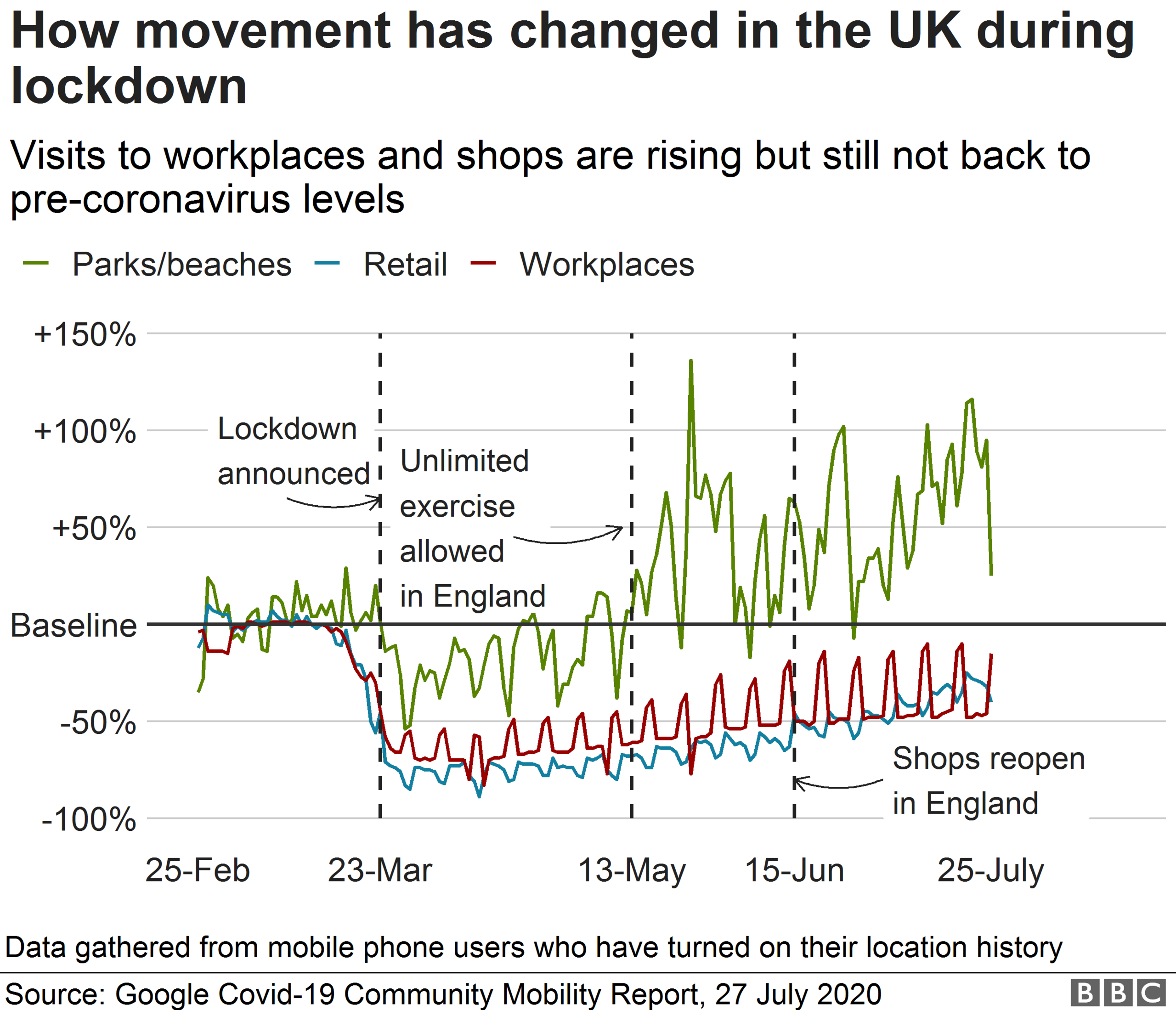
While more people are returning to the workplace, these trips are still well below February levels.
In London, in the week to 25 July, workplace visits were down by about 45% compared with January.
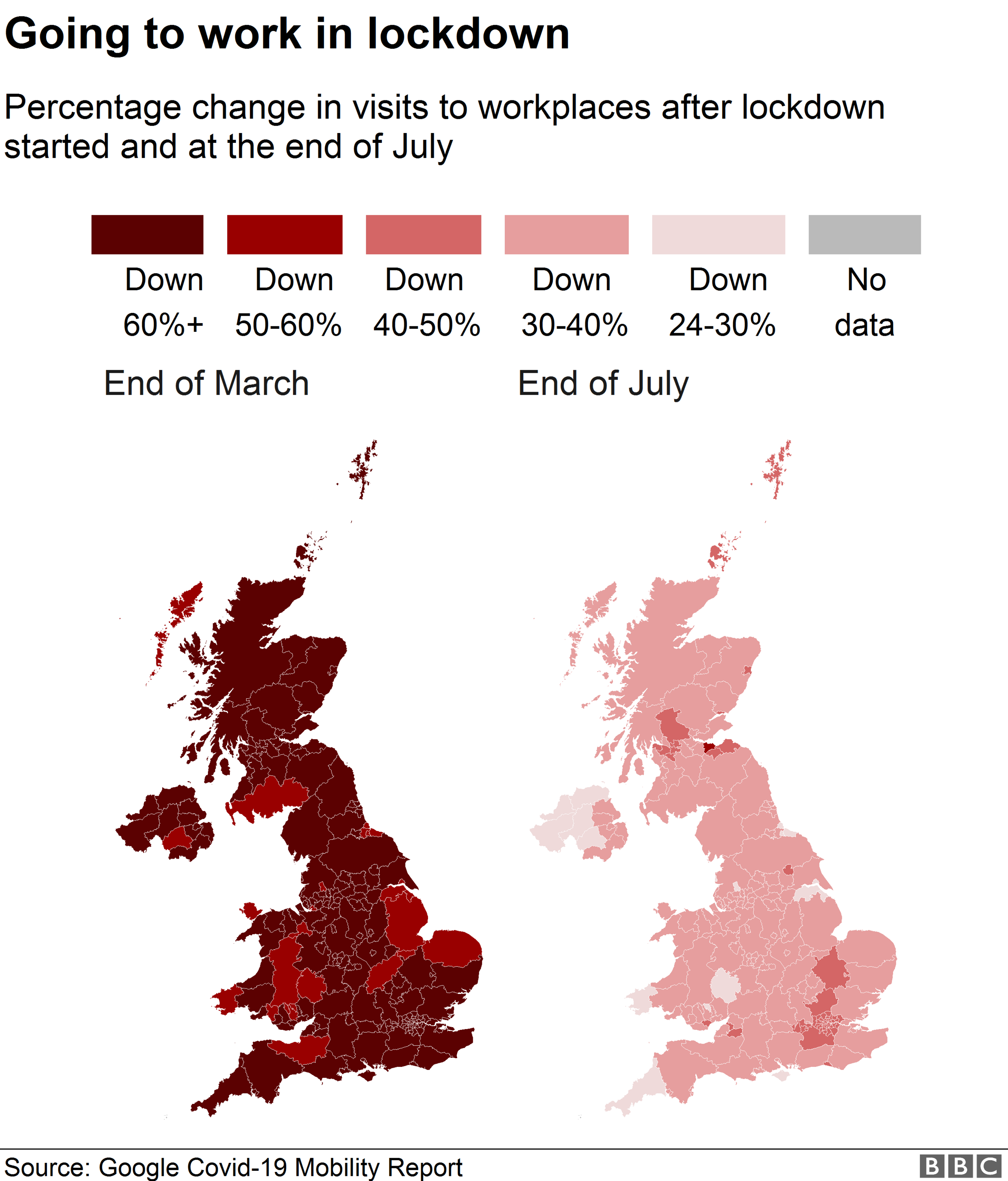

Cardiff has a similar rate, while in Edinburgh levels are still down by more than half and in Belfast by about 40%.
After the lockdown was imposed on 23 March, workplace visits fell by 75% according to the data, which tracks the mobile phones of people with their location history turned on.
2) Online sales couldn't rescue the struggling High Street
While supermarkets stayed open throughout the pandemic, ''non-essential'' shops had to close, which was bad news for the embattled UK High Street.
After falling sharply, sales of non-food items started to recover in May, and have bounced back further since shops were allowed to reopen in June.
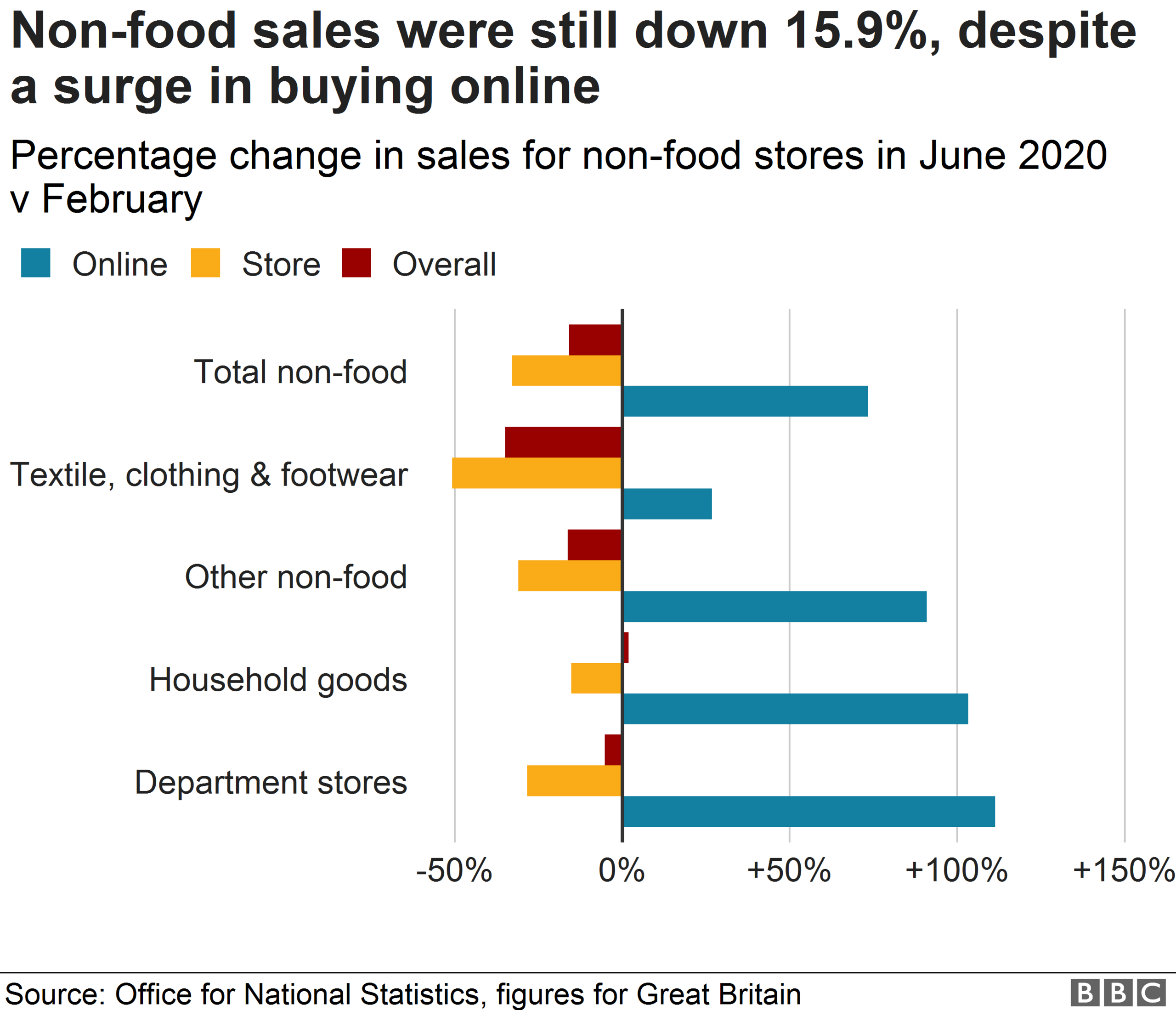
While many shops continued to sell goods online, the surge in online sales didn't cancel out the decline of in-store purchases, with total non-food sales down 15.9% in June compared with pre-lockdown levels.
For department stores, online sales more than doubled in June, but overall sales fell more than 5% compared with February.
By contrast, stores selling household goods bucked the trend with a slight overall sales increase, boosted by the home improvements boom.
3) Pub and restaurant staff started going back to work
Just under one in five workers (18.5%) in the UK were on furlough in the first half of July, according to the Office for National Statistics (ONS).
This included nearly two-thirds of those in the arts, entertainment and recreation sector, which is still greatly affected by the restrictions.
More than nine million jobs have been covered by the furlough scheme since March. It pays up to 80% of the salary of those placed on leave (up to a maximum of £2,500 a month) because of the coronavirus pandemic.
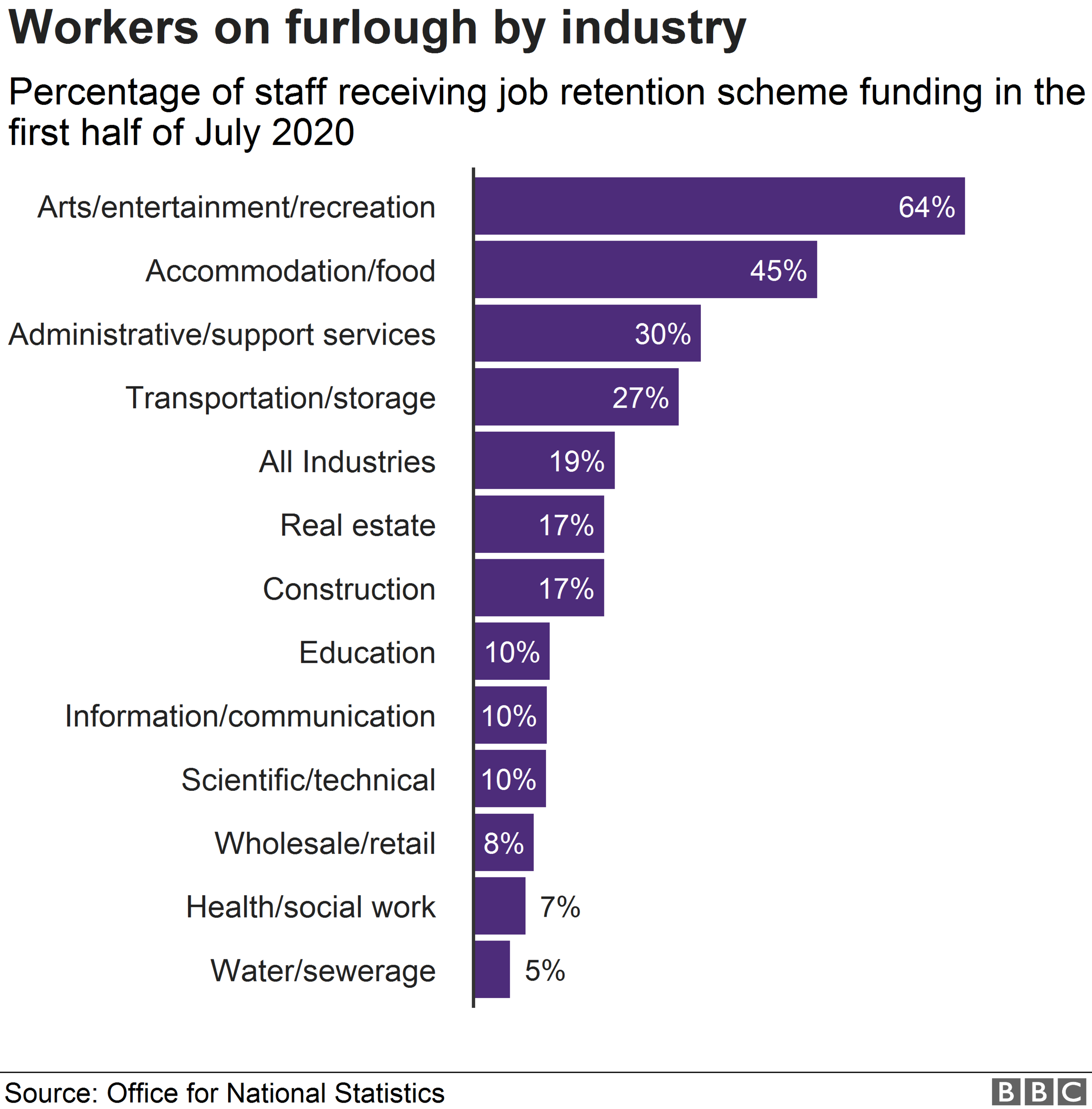
From 4 July, pubs, restaurants and hotels in England could reopen. This prompted about 15% of all workers in accommodation and food services to return to their jobs in the first half of the month, the highest proportion of any sector.
4) Restaurant bookings are creeping back up
Bookings are creeping back up again now that restaurants and other food venues are allowed to reopen.
However, they are still down by more than a third compared with last year, according to figures from booking service OpenTable.
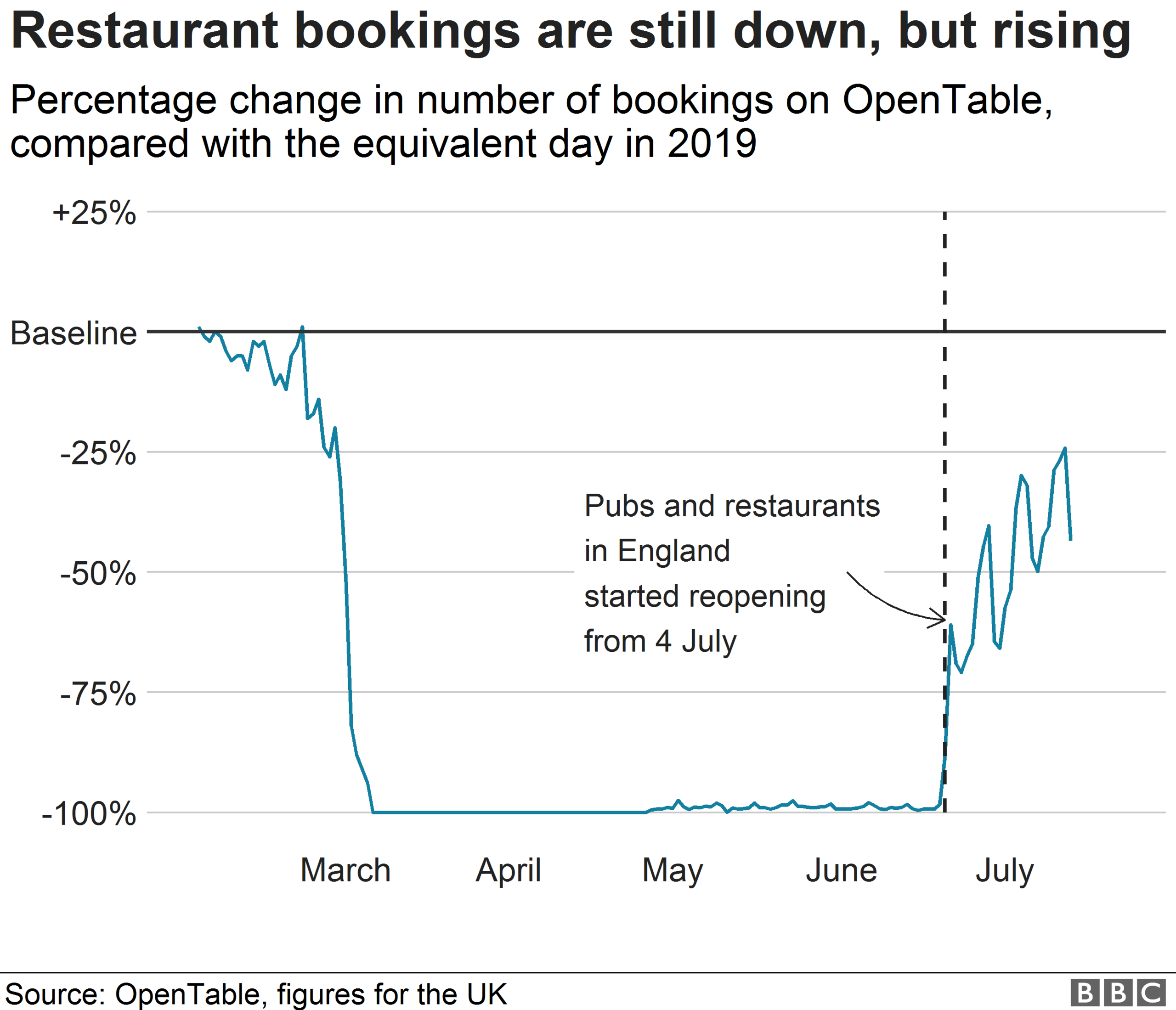
Some restaurants have introduced a bookings-only policy to help manage capacity under social distancing rules, but some have complained that customers are not showing up.
In the five days to 19 July, 52% of UK adults surveyed by the ONS said they would feel comfortable eating at a restaurant, up from 47% the week before.
But restaurant visits may increase under the government's ''eat out to help out'' August discount scheme, which is designed to help boost confidence in dining out.

5) Shielding compliance in England was already falling
The 2.2 million people in England classed as clinically extremely vulnerable have been told they can stop shielding, but they are advised to take extra care outside the home.
The level of commitment to shielding fell slightly by June 24-30, as the lockdown started to ease for other groups. But over half of those shielding in England were still following the guidance ''completely'' - 58%, down from 63% in May.
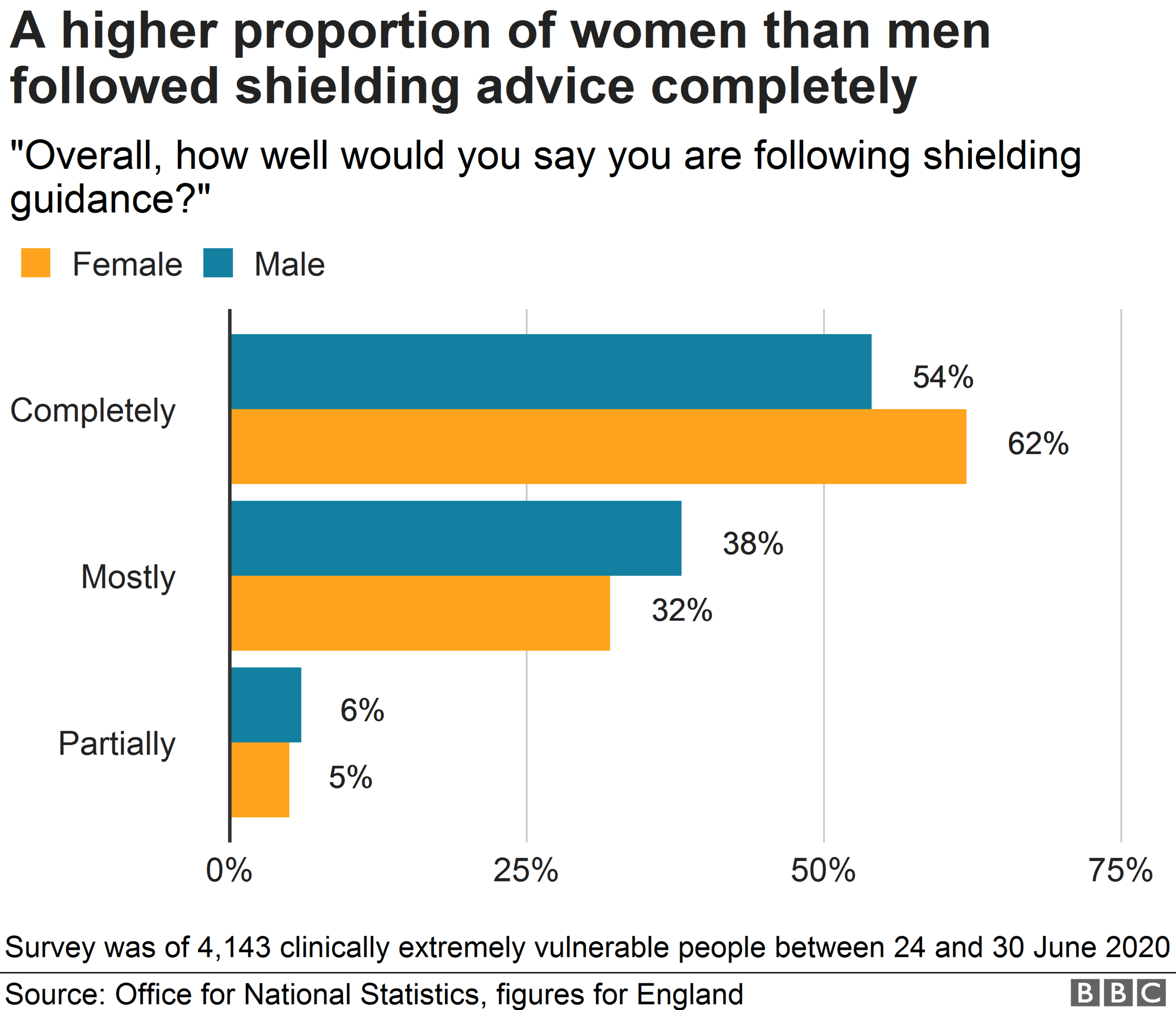
Almost nine out of 10 people shielding reported having no visitors except for care reasons in May. By the end of June it was 77%.
A higher proportion of women (62%) than men (54%) followed shielding advice to the letter, according to the ONS
6) The number of coronavirus-related fines has fallen significantly
Police handed out more than 18,000 fixed penalty notices in England and Wales between 27 March and 20 July. These peaked around the Easter Bank Holiday and were mainly for breaking restriction of movement rules. In Scotland, more than 3,000 were handed out over the same period.
Since restrictions have started to ease, the number of fines has fallen sharply.
Across Scotland, England and Wales, Cumbria and North Yorkshire handed out the highest proportion of fines, and Staffordshire and West Midlands the least.
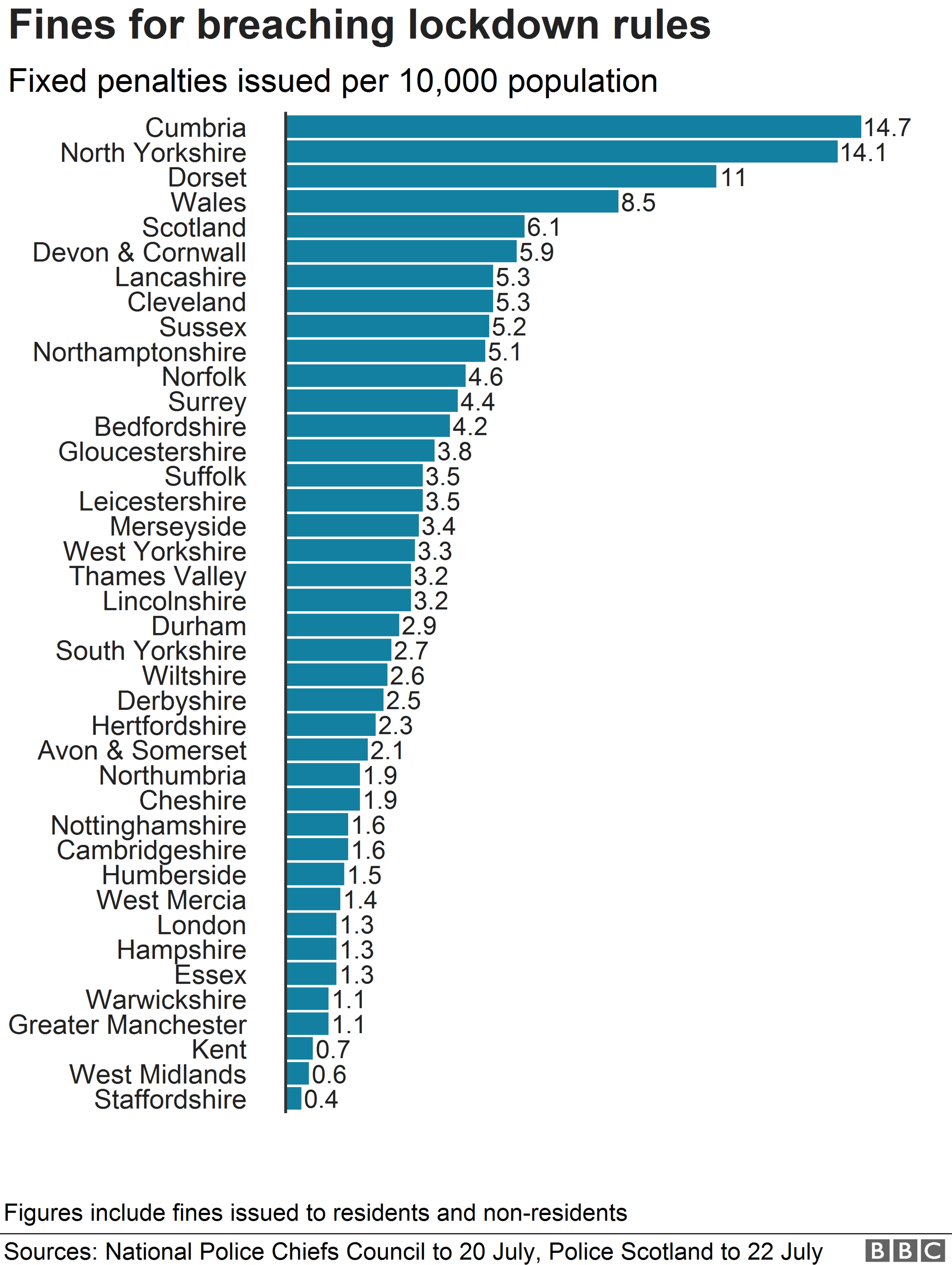

In England, wearing a face covering became compulsory on public transport on 15 June, and in many enclosed public spaces on 24 July.
Between 15 June and 20 July, 32 people in England and Wales were fined for not wearing a face covering on public transport, while just one person was fined for not obeying quarantine rules after returning from abroad.
7) The number of online job adverts has halved
As the long-term financial effects of the pandemic start to take hold, it appears some employers are putting hiring plans on ice.
About half as many online job adverts were posted during 17-24 July as the 2019 average, ONS analysis of job website Adzuna suggests.
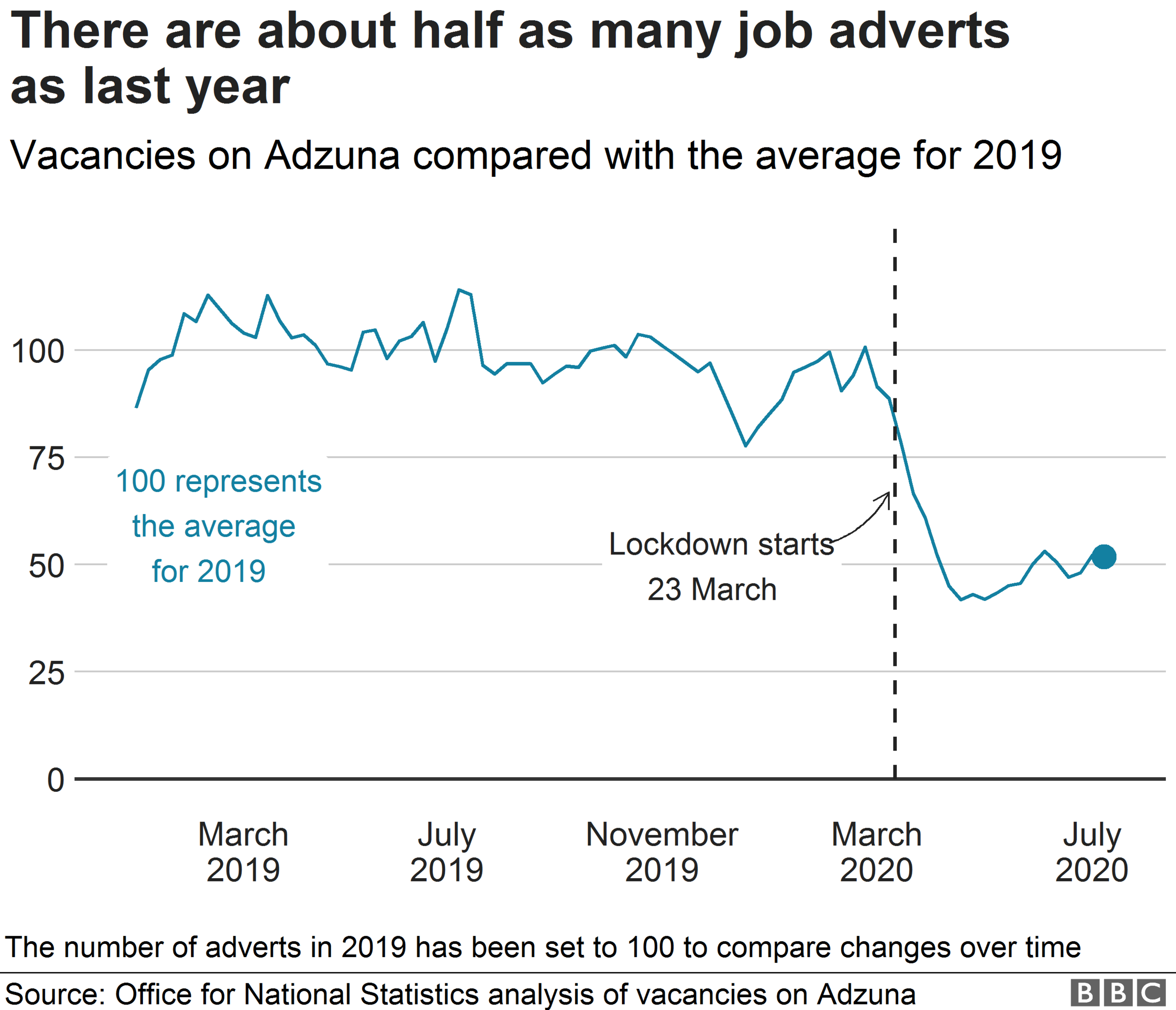
The number of available jobs plummeted in some areas, with vacancies in the charity and voluntary sector falling by more than 85%, and management and consulting jobs down about 78%.
But availability in some sectors has almost returned to last year's levels. Health and social care vacancies are at about 93% of their 2019 level, rising to 98% for jobs in facilities and maintenance.
8) Air pollution overtook last year at times
In the spring, lower levels of travelling made a difference to the environment, with air pollution dropping compared with last year.
Average readings of nitrogen dioxide, one of the main pollutants from vehicles, were lower throughout lockdown than on equivalent days of the week in 2019.
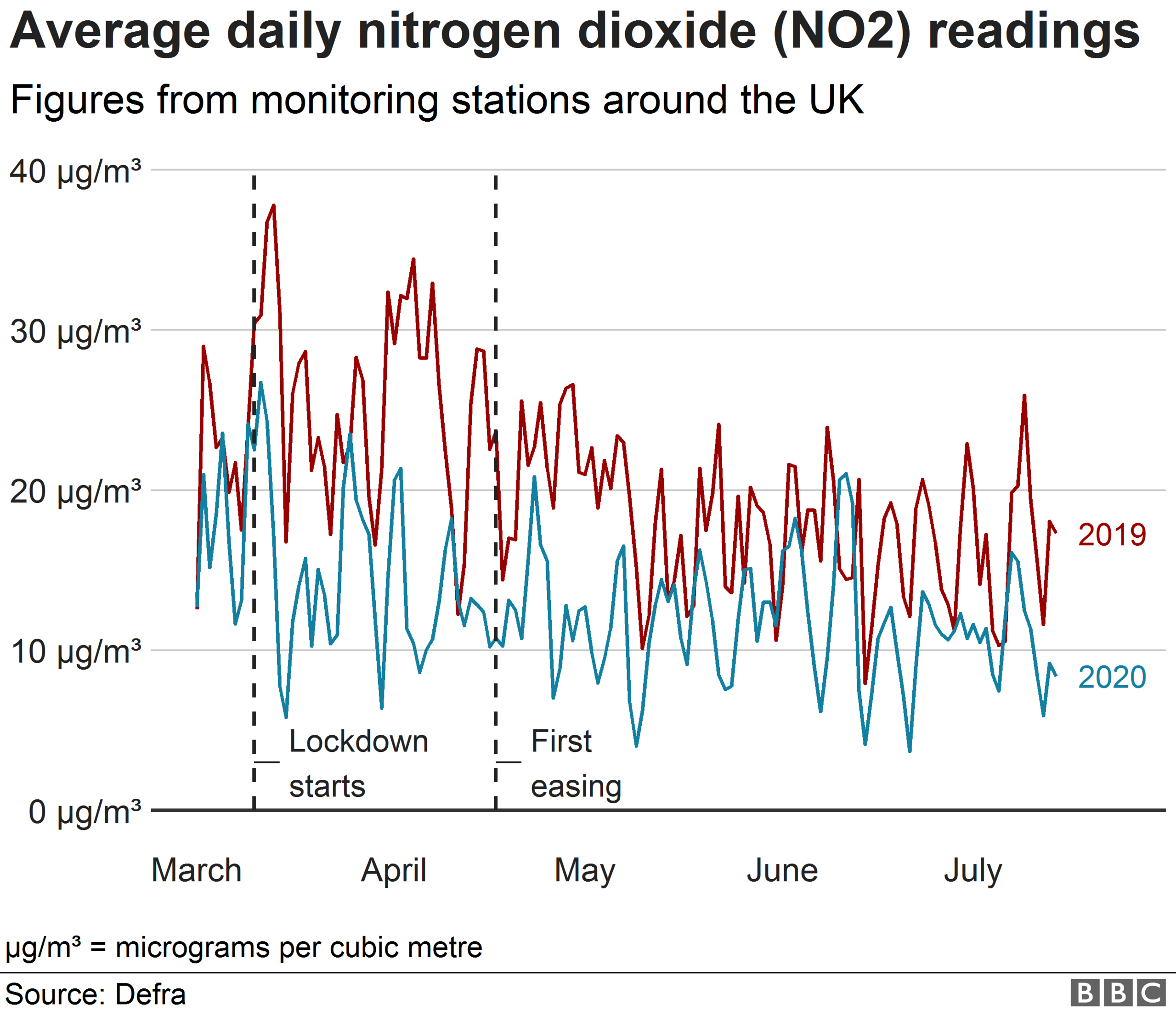
But the gap narrowed after restrictions started to ease in May, and most people were able to travel further afield.
At some points in June and July, readings were as high or higher than the equivalent day last year.

SOCIAL DISTANCING: What are the rules now?
FACE MASKS: When should you wear one?
TESTING: Who can get a test and how?
THE R NUMBER: What it means and why it matters

This piece was first published on 13 April and has been updated to include the latest statistics.